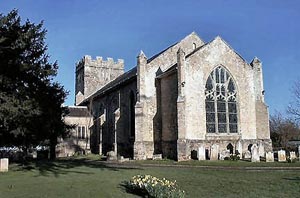
Parish Church History
Most of the information was originally compiled by Mr Jim Gallimore after several years of research. He died in 1995.
With kind permission of the Rev Jean de Garis
The church website can be found at www.lytup.church

Records of the history of this church are sparse, and the dedication is “officially unknown.” For a church to be without a dedication is not unique, and indicates an unwillingness to choose or retain a saint's name. There is speculation that the name of the nearby public house (St. Peter’s Finger) may have a bearing on the original name of the church. The registers and other parish documents are in the Dorset County Archives, in Dorchester. They date back to 1554, in the reign of Mary Tudor. The word “Minster” is an old English alternative for monastery, and therefore suggests a monastic community on this site in medieval times.
The present nave was erected in 1833 to replace the previous building which had been destroyed by fire. The builder was John Tullock of Wimborne, and soft stock bricks from Upton Brick Works were used, with rubble from the old church forming part of the lower walls. The very short sanctuary, without a choir or chancel, indicates some Saxon influence. The church came under the parish of Sturminster Marshall until the 1850's.
The tower is built of local “heathland” red sandstone, and has been variously dated as “medieval”, 1250, and “even earlier than 1250, judging by the early English windows”. It was re-roofed in 1961-2. The font is octagonal and probably dates from the 16th century.
Inside the tower the present ring of six bells was completed in 1910, although the oldest of these bells dates back to around 1490. Renovation has continued through this century, and in 1994 all six bells were removed, refurbished, re-tuned and re-hung. Other substantial work inside the tower has ensured the safety and good order of the bells for many years to come.
The inner doors in the porch, of Spanish origin, came from South Lytchett Manor, and form a Lees family memorial together with the plaques on either side of the doors. The stained glass windows on the north and south walls are also Lees memorials. One of them depicts the story of St. Martin, the French saint, who as a soldier cut his cloak in half for a beggar, and afterwards in a dream realised that he had done this for Christ. The east window was installed to commemorate the Diamond Jubilee of Queen Victoria's reign from 1837 to 1897, and these dates can be seen in small panes at the top of the window. The central figure is Christ the King reigning in glory.
The layout of the sanctuary and east end was substantially changed in 1977, during the Revd. Douglas Mortimer's time as Vicar. The sanctuary floor was extended and carpeted, and a new altar and lectern were provided, with benches taking the place of the communion rail which was previously under the sanctuary arch. Major restoration work on the interior took place in 1984-5. An entirely new floor had to be laid and the pews were replaced by the present chairs.
Outside the church, on the south side and on part of the buttress where the nave and sanctuary join, there is a dark stone carved with radiating lines, and Roman numerals. This is a “mass-dial” or “scratch-dial”, and is a primitive time-teller which is usually marked to show the times of Mass. It is a rare example of its kind, and is tentatively dated no later than 1500. Further evidence of the early church is a piece of stonework near the tower, recognised as part of the base of the preaching or churchyard cross, dating probably from the 14th century. The quadruple sundial over the outer doors of the porch, with its miniature parapet and crocketed finials above, dates from about 1700.
In the churchyard west of the tower can be found the grave of Sir Francis Younghusband, soldier, explorer and mystic, who died in Lytchett Minster in 1942. Above the inscription on the gravestone are the Himalayan mountains which he crossed in 1904.
The war memorial to those of the parish who died in the two world wars was restored in 1995 by Lytchett Minster and Upton Town Council and the British Legion.
The Church was redecorated in 2001 and a wainscot added to the Chancel arch, together with a new shelf on top of the wainscot all the way around the Church.